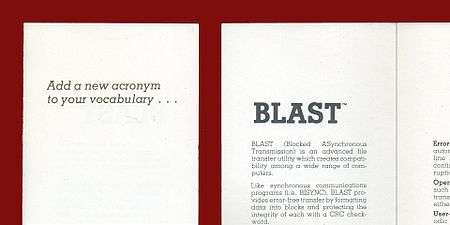BLAST (protocol)
BLAST (BLocked ASynchronous Transmission), like XMODEM, is a communications protocol designed for file transfer over asynchronous communication ports and dial-up modems that achieved a significant degree of popularity during the 1980s.[1][2][3][4][5][6][7][8] Reflecting its status as a de facto standard for such transfers, BLAST, along with XMODEM, was briefly under official consideration by ANSI in the mid-80s as part of that organization's ultimately futile attempt to establish a single de jure standard.[9][10]

Overview
BLAST grew out of the mission-critical experience of providing air pollution telemetry within the dial-up communications environment of the petroleum belt of southern Louisiana and Texas, with not only noisy telephone lines but also unexpected satellite hops to remote locations.[11][12] As such, BLAST was the only asynchronous protocol to have entered the 1980s computing arena with all of the following features:
- bit-oriented data encoding
- CRC (cyclic redundancy check) error detection
- a sliding window block transmission scheme
- selective retransmission of corrupted blocks
- simultaneous bi-directional data transfer
BLAST thus gained a reputation as the protocol having the best combination of speed and reliability in its class.[1][2][3][4][5][7][8][13][14][15][16]
| “ | Our tests showed that when connected to a host running BLAST, MacBLAST provides the most error-free and fastest file transfers we've yet seen ... MacBLAST to BLAST never lost data and never blew a connection in our tests. | ” |
| — Don Crabb, "MacBLAST carves a place for itself in communications applications", MacWEEK (February 21, 1989) | ||
History
The idea for the BLAST product belongs to Paul Charbonnet, Jr., a former Data General salesman. Its original version was designed and implemented for the Data General line of Nova minicomputers by G. W. Smith, a former BorgWarner Research Center systems engineer who, having developed a basic "ack-nak" protocol for the aforesaid telemetry application, now created an entirely new protocol with all of the above-mentioned features, and for which he devised the "BLAST" acronym.[11][17]
This work was performed under contract to AMP Incorporated, of Baton Rouge, LA. However, it was another Baton Rouge company, Communications Research Group (CRG), which was to successfully commercialize the BLAST protocol, and which was also to employ Charbonnet and Smith as, respectively, Sales Director and Vice-president of Research and Development.[11][12] CRG was later acquired by U.S. Robotics, which continued to develop and sell BLAST products.[18]
On the downside, BLAST was criticized by XMODEM developer Chuck Forsberg because of its proprietary nature, making it "tightly bound to the fortunes of [its supplier]".[19]
See also
References
- 1 2 Crabb, Don (February 21, 1989). "MacBLAST carves a place for itself in communications applications" (PDF). MacWEEK. Retrieved April 28, 2017.
- 1 2 Staff, Computers in Defence (May 13, 1985). "Maritime Satellite Communications" (PDF). Computers in Defence. Retrieved January 31, 2014.
- 1 2 Held, Gilbert (March 1986). "Evaluating microcomputer communications software" (PDF). Data Communications. Retrieved February 16, 2014.
- 1 2 Magidson, Steve (May 15, 1989). "Moving Files Can Be A BLAST" (PDF). UNIX Today. Retrieved March 21, 2014.
- 1 2 "Package Offers Async Link Between Systems" (PDF). PC Week. February 10, 1987. Retrieved October 5, 2014.
- ↑ "Partial Listing of BLAST Users" (PDF). September 1, 1985. Retrieved 11 February 2014.
- 1 2 Honig, David A.; Hoover, Kenton A. (1990). Desktop Communications: IBM PC, PS/2 & Compatibles (PDF). Wiley. ISBN 0-471-60613-8. Retrieved May 4, 2014.
- 1 2 Held, Gilbert (1991). Understanding Data Communications: From Fundamentals to Networking (PDF). Wiley. ISBN 978-0-471-93051-8. Retrieved April 24, 2017.
- ↑ "X12 Guideline, Entry Level, Asynchronous Transmissions" (PDF). December 5, 1985. Retrieved 3 December 2013.
- ↑ "Minutes of Async Sub group of X12C1" (PDF). February 17, 1986. Retrieved 3 December 2013.
- 1 2 3 Smith, G. W. "Aesthetic Wilderness: A Brief Personal History of the Meeting Between Art and the Machine", Birds-of-the-Air Press, 2011. ISBN 978-0-9846655-1-8
- 1 2 Estill, Lyle "Small is Possible: Life in a Local Economy", New Society Publishers, 2008. ISBN 978-0-86571-603-2
- ↑ "Xmodems: The right blend?" (PDF). Computerworld. May 13, 1985. Retrieved January 28, 2014.
- ↑ Southerton, Alan (January 1990). "BLAST Rockets Your Data" (PDF). UNIX WORLD. Retrieved August 13, 2014.
- ↑ Charbonnet Jr, Paul; Smith, Glenn (January 18, 1984). "BLASTing the Way to Synchronous Communications" (PDF). Computerworld. Retrieved November 2, 2014.
- ↑ Smith, G. W. & Rubenstein, P. (1984). "The Async Route -- Best Suited for a Microcomputer's Local Traffic". Data Communications.
- ↑ Hall, John (February 18, 1989). "La. Pitches (Soft)wares East" (PDF). The Times-Picayune. Retrieved January 1, 2015.
- ↑ "U.S.Robotics advertisement for BLAST Remote Control". PC Mag. October 13, 1992. Retrieved December 29, 2016.
- ↑ "XMODEM/YMODEM Protocol Reference" (PDF). 1988. Retrieved May 6, 2017.